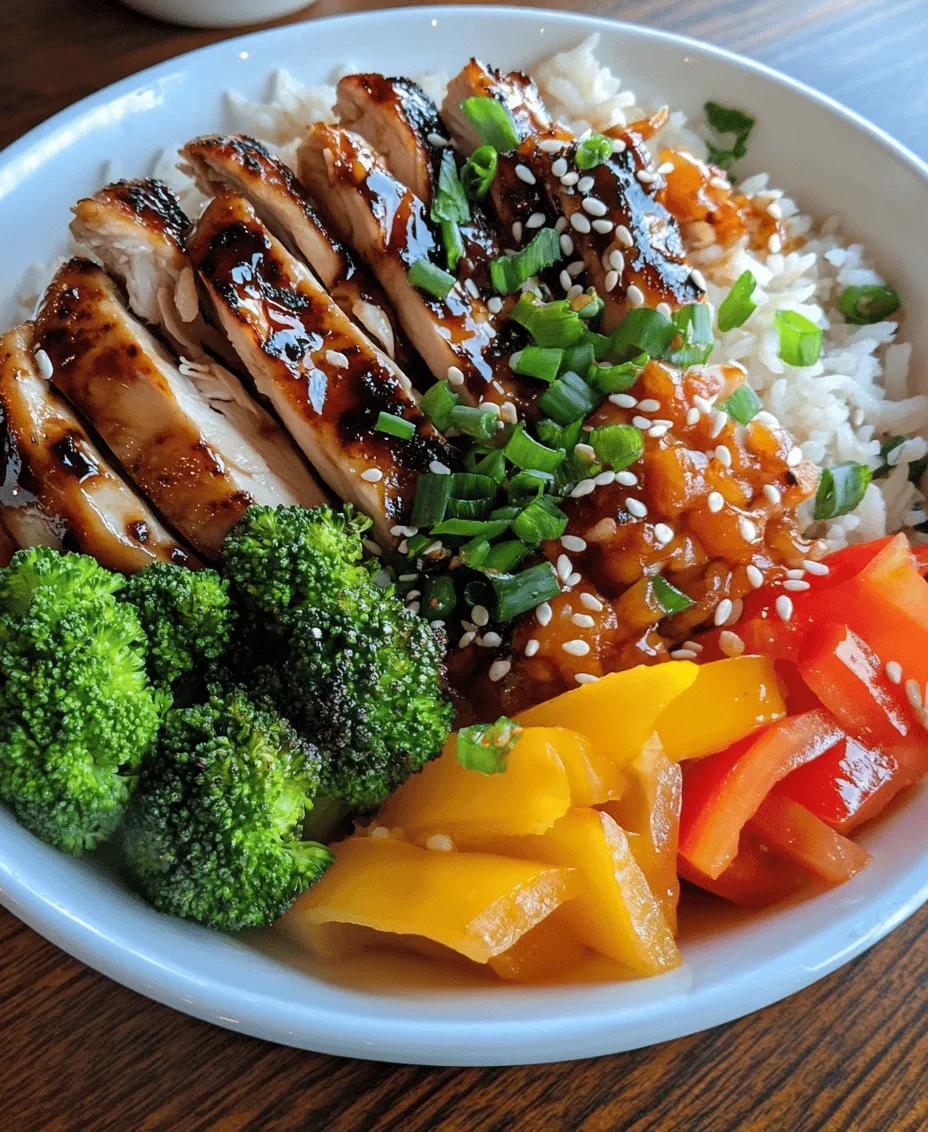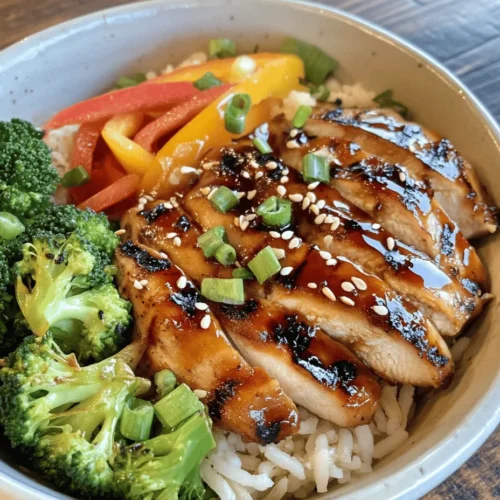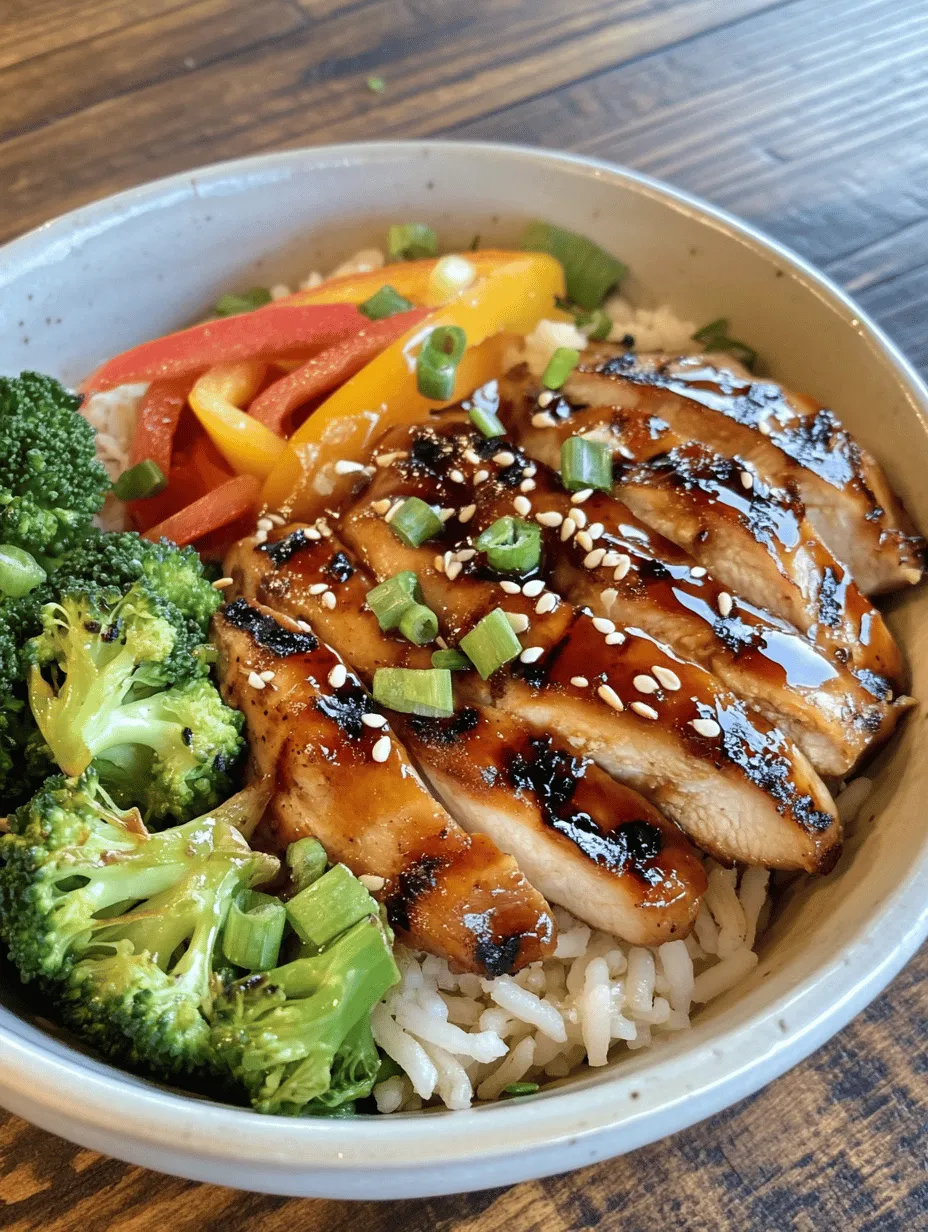Introduction
If you’re searching for a dish that beautifully balances savory, sweet, and slightly tangy flavors, the Teriyaki Chicken Rice Bowl is a culinary gem that deserves a spot on your dining table. This delightful meal combines tender marinated chicken with fragrant rice and vibrant vegetables, making it not only a feast for the palate but also a visual delight. Originating from Japan, teriyaki refers to a cooking technique that involves grilling or broiling food while basting it in a sweet soy sauce marinade. This method has transcended borders, becoming a beloved favorite in various cuisines around the world.
The popularity of Teriyaki Chicken Rice Bowls can be attributed to their satisfying taste and the convenience they offer. Whether enjoyed at a bustling restaurant or crafted in the comfort of your kitchen, these bowls have a universal appeal that resonates with food lovers everywhere. However, there’s something uniquely rewarding about making this dish at home. When you prepare your own Teriyaki Chicken Rice Bowl, you have full control over the ingredients, allowing you to customize flavors and avoid additives often found in takeout versions. The result? A fresher, healthier meal that satisfies your cravings without compromising on taste.
The Allure of Teriyaki Chicken Rice Bowls
At the heart of the Teriyaki Chicken Rice Bowl is the teriyaki cooking method, which involves marinating the chicken in a blend of soy sauce, mirin, and other flavor-enhancing ingredients. This creates a signature glaze that clings to the chicken, infusing it with rich umami flavor. The term “teriyaki” itself derives from the Japanese words “teri,” meaning glaze, and “yaki,” which refers to grilling or cooking. This technique is not only limited to chicken; it can be applied to a variety of proteins, making it incredibly versatile.
Nutritionally, Teriyaki Chicken Rice Bowls shine with their wholesome ingredients. The chicken provides a significant source of lean protein, which is essential for muscle repair and growth. The addition of vegetables like broccoli and bell peppers adds not only color and crunch but also a wealth of vitamins and minerals. Broccoli is particularly rich in vitamins C and K, while bell peppers contribute antioxidants and fiber. By incorporating a variety of vegetables, you can tailor the dish to your preferences and boost its health benefits.
One of the key appeals of a Teriyaki Chicken Rice Bowl is its versatility. While the classic version features chicken, you can easily swap in other proteins such as tofu, shrimp, or beef, making it suitable for various dietary preferences. Additionally, the base of the dish can be customized with different types of rice or even quinoa for a healthier alternative. The possibilities are endless, inviting experimentation and creativity in the kitchen.
Ingredients Breakdown
To create a delectable Teriyaki Chicken Rice Bowl, you’ll need a selection of key ingredients that work together to achieve a perfect balance of flavors. Each component plays a vital role in the dish’s overall appeal. Let’s take a closer look at what you will need:
Boneless, Skinless Chicken Thighs
Starting with the protein, boneless, skinless chicken thighs are highly recommended for this dish. Thighs are more tender and flavorful compared to chicken breasts, which can dry out during the cooking process. They absorb the marinade beautifully, resulting in juicy, flavorful bites. If you prefer a leaner option, chicken breasts can be used, but they may require careful cooking to prevent dryness.
Soy Sauce
Soy sauce is the backbone of the teriyaki marinade, contributing its distinct salty and umami notes. There are several varieties of soy sauce available, including regular, low-sodium, and tamari (a gluten-free option). Each type has its flavor nuances, with regular soy sauce being the most commonly used. Low-sodium soy sauce is a great choice for those looking to reduce their sodium intake while still enjoying the rich flavor.
Mirin or Rice Wine
Mirin, a sweet Japanese rice wine, is another essential ingredient in the teriyaki marinade. It adds depth and sweetness, helping to balance out the saltiness of the soy sauce. If mirin is not readily available, a combination of rice vinegar and sugar can serve as a substitute, although the flavor profile may vary slightly.
Brown Sugar
Brown sugar adds a touch of sweetness to the marinade, enhancing the overall flavor and creating a beautiful glaze when cooked. The molasses content in brown sugar provides additional depth, making it an ideal choice for teriyaki sauce. If you prefer a less sweet flavor, you can adjust the amount of sugar to your liking.
Grated Ginger and Minced Garlic
For a burst of flavor, grated ginger and minced garlic are essential additions to the marinade. Ginger not only contributes a warm spiciness but also boasts numerous health benefits, including anti-inflammatory properties. Garlic adds aromatic depth and enhances the overall flavor profile of the dish. Together, they create a fragrant base that elevates the teriyaki sauce.
Sesame Oil
A drizzle of sesame oil adds a nutty depth to the dish, complementing the other flavors beautifully. It’s important to use toasted sesame oil for this recipe, as it imparts a richer flavor. Just a small amount goes a long way in enhancing the overall taste of the Teriyaki Chicken Rice Bowl.
Jasmine Rice
When it comes to the base of the dish, jasmine rice is the preferred choice. Its fragrant aroma and fluffy texture pair perfectly with the teriyaki sauce, absorbing the flavors beautifully. However, if you prefer brown rice or another grain, feel free to substitute according to your dietary preferences.
Broccoli and Bell Peppers
To add color, nutrition, and crunch, incorporating vibrant vegetables like broccoli and bell peppers is essential. Broccoli is an excellent source of vitamins C and K, while bell peppers provide antioxidants and a sweet crunch. You can easily customize the vegetables based on your preference or seasonal availability, making this dish adaptable to your taste.
Green Onions and Sesame Seeds
To finish off the Teriyaki Chicken Rice Bowl, a sprinkle of sliced green onions and sesame seeds adds a delightful crunch and pop of freshness. Green onions offer a mild onion flavor, while sesame seeds provide a nutty crunch that complements the dish beautifully. These finishing touches elevate the presentation while enhancing the flavor, making your meal visually appealing.
Marination Process for Optimal Flavor
The marination process is crucial for achieving maximum flavor in your Teriyaki Chicken Rice Bowl. To start, combine the soy sauce, mirin, brown sugar, grated ginger, minced garlic, and sesame oil in a bowl, whisking them together until the sugar dissolves. This mixture forms the base of your teriyaki marinade.
Next, place the boneless, skinless chicken thighs in a resealable plastic bag or a shallow dish, and pour the marinade over the chicken. Ensure that the chicken is well-coated, then seal the bag or cover the dish. For the best results, marinate the chicken in the refrigerator for at least 30 minutes, although longer marination (up to overnight) will yield even more flavor. The acidity from the marinade helps to tenderize the chicken while infusing it with the rich, savory notes characteristic of teriyaki.
Once the chicken is marinated, it’s time to cook. You can choose to grill, bake, or sauté the chicken based on your preference, each method providing a unique texture and flavor profile. The key is to cook the chicken until it reaches an internal temperature of 165°F (75°C), ensuring that it remains juicy and flavorful.
With the marinated chicken ready for cooking, the next steps will involve preparing the rice and vegetables to create a complete and satisfying Teriyaki Chicken Rice Bowl. The combination of perfectly cooked rice, tender chicken, and vibrant vegetables promises a meal that will delight your taste buds and leave you feeling nourished.
Stay tuned for the next section, where we will delve into the cooking process and how to assemble your Teriyaki Chicken Rice Bowl for the ultimate dining experience.

Importance of Marinating Chicken
Marinating is a crucial step in achieving the full flavor potential of your Teriyaki Chicken Rice Bowl. The marinade not only imparts taste but also enhances the chicken’s tenderness. When marinated properly, the chicken absorbs the sauce’s flavors, creating a deliciously savory dish that stands out.
Suggested Marination Times for Flavor Enhancement
For optimal results, marinate your chicken for at least 30 minutes, but for the best flavor, aim for 2 to 4 hours. If time allows, marinating overnight in the refrigerator can significantly deepen the flavors. Just be cautious not to over-marinate; chicken should not sit in the marinade for more than 24 hours to avoid a mushy texture.
Tips for Making the Most of the Marinade
– Use a Zip-top Bag: To ensure even coating, place your chicken in a zip-top bag with the marinade. Seal and massage the bag to distribute the marinade thoroughly.
– Add Fresh Ingredients: Enhance the marinade with fresh garlic, ginger, or green onions, which can elevate the flavor profile.
– Reserve Some Marinade: If you want to use the marinade as a sauce later, reserve a portion before adding the raw chicken. This prevents cross-contamination.
Cooking Techniques Explained
Step-by-Step Guide on Cooking Chicken to Achieve Perfect Sear and Flavor
1. Preheat Your Skillet: Use a heavy-bottomed skillet or a cast-iron pan for even heat distribution. Preheat it on medium-high heat until it is hot but not smoking.
2. Remove Excess Marinade: Take the chicken out of the marinade and let any excess drip off. This step is crucial for achieving a perfect sear.
3. Add Oil: Drizzle a bit of oil in the skillet (canola or vegetable oil works best). Swirl to coat the bottom.
4. Sear the Chicken: Place the chicken pieces in the skillet without overcrowding. Cook for 4-5 minutes on one side without moving them; this allows a crust to form.
5. Flip and Finish Cooking: Flip the chicken and lower the heat slightly. Cook for an additional 4-5 minutes until the internal temperature reaches 165°F (75°C). Remove the chicken from the skillet and let it rest before slicing.
The Art of Stir-Frying Vegetables: Retaining Texture and Nutrients
To keep your vegetables crisp and vibrant, follow these steps:
1. Prepare Your Vegetables: Cut vegetables into uniform sizes for even cooking. Bell peppers, broccoli, and snap peas are great choices that complement teriyaki flavors.
2. High Heat is Key: Use high heat for stir-frying to quickly cook the vegetables while retaining their crunch.
3. Add in Stages: Start with the vegetables that take longer to cook, such as broccoli, and add quicker-cooking items like bell peppers and snap peas later.
4. Avoid Overcrowding the Pan: Stir-fry in batches if necessary. Overcrowding can lead to steaming rather than frying.
Importance of Using the Same Skillet for Flavor Infusion
Cooking your vegetables in the same skillet where you seared the chicken allows the flavors to meld beautifully. The residual marinade and juices left in the pan create a rich, savory backdrop for the vegetables. After removing the chicken, simply add a touch more oil if needed, and toss in your vegetables, scraping up any flavorful bits stuck to the bottom.
Assembling the Perfect Rice Bowl
Layering Techniques for Visual Appeal and Flavor Distribution
Creating a visually appealing rice bowl is an art form that enhances the dining experience. Start with a base of steamed rice, then:
1. Add Chicken: Slice the rested chicken and arrange it in the center.
2. Vegetable Placement: Neatly arrange your stir-fried vegetables around the chicken for a colorful presentation.
3. Drizzle Sauce: Spoon some teriyaki sauce over the chicken and vegetables to tie the flavors together.
4. Garnish: Finish with fresh toppings such as sliced green onions, sesame seeds, or pickled ginger.
Recommendations for Portion Sizes
For a balanced meal, consider a portion of about 1 cup of rice, 4-6 ounces of chicken, and a generous serving of vegetables. Adjust according to your dietary needs and preferences.
Creative Ideas for Additional Toppings and Variations
– Nuts and Seeds: Add toasted sesame seeds or chopped peanuts for an extra crunch.
– Spicy Kick: Include sliced jalapeños or a drizzle of sriracha for heat.
– Fresh Herbs: Top with cilantro or basil for freshness.
– Alternative Proteins: Substitute chicken for tofu or shrimp for a different flavor and texture.
Serving Suggestions
Ideal Accompaniments
To complement your Teriyaki Chicken Rice Bowl, consider serving:
– Side Dishes: Miso soup or edamame are excellent choices that enhance the meal.
– Beverages: Pair with green tea or a light sake for a refreshing combination.
Presentation Ideas for Serving Guests
When hosting, presentation is key. Use colorful bowls or plates, layer the ingredients attractively, and consider garnishing with a sprig of cilantro or a lime wedge for a pop of color. For a more casual setting, serve family-style, allowing guests to assemble their bowls.
Health and Nutrition Insights
Calorie and Nutritional Breakdown of the Dish
A standard Teriyaki Chicken Rice Bowl can contain approximately 500-700 calories, depending on portion sizes and additional toppings. Here’s a quick nutritional breakdown:
– Protein: Chicken is a great source of lean protein, essential for muscle repair and growth.
– Carbohydrates: Rice provides energy, and when paired with vegetables, it enhances fiber intake.
– Fats: Healthy fats can be included through the use of sesame oil or nuts in moderation.
Discussion of Possible Dietary Adaptations
– Gluten-Free: Use gluten-free soy sauce or tamari in the marinade.
– Low-Carb: Substitute rice with cauliflower rice or zucchini noodles.
– Vegan Option: Replace chicken with tofu or tempeh marinated in the same teriyaki sauce.
Benefits of Incorporating More Home-Cooked Meals
Cooking at home allows control over ingredients and portion sizes, making meals healthier. It also provides an opportunity to experiment with flavors and ingredients, fostering creativity in the kitchen.
Conclusion
In conclusion, making Teriyaki Chicken Rice Bowls at home is not only a delicious choice but also an easy one that can be customized to suit your preferences. The joy of cooking this dish lies in the balance of flavors and the satisfaction of sharing it with loved ones. With a few simple techniques and creative toppings, you can turn this meal into a family favorite. So, grab your ingredients, marinate that chicken, and get ready to enjoy a wholesome, flavorful meal that brings everyone together at the table. Cooking is not just about nourishment; it’s about creating memories and enjoying the simple pleasure of good food.



